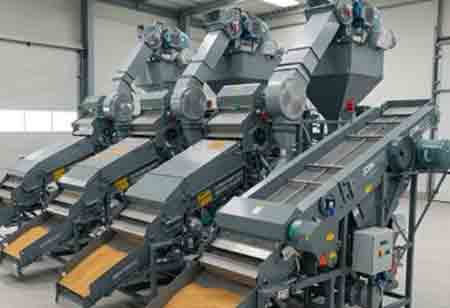Thank you for Subscribing to Agri Business Review Weekly Brief
Custom Solutions in Grain Cleaning: Meeting Diverse Needs

By
Agri Business Review | Tuesday, April 22, 2025
Stay ahead of the industry with exclusive feature stories on the top companies, expert insights and the latest news delivered straight to your inbox. Subscribe today.
The push for greener equipment isn’t just coming from customers. Regulations are getting stricter in many countries, especially around dust emissions and energy use.
Grain cleaning equipment manufacturers are experiencing a shift. The demand is no longer just about removing foreign material from harvested grain. It’s about doing it faster, more efficiently, and more precisely. Farmers, grain elevators, and commercial processors expect their equipment to keep up with global grain production’s growing pace and scale. This pressure has pushed manufacturers to innovate or risk falling behind. Modern grain cleaning machines are being designed with speed, automation, and ease of maintenance in mind.
Customers want machines that can be quickly adjusted to handle different types of grain or contamination levels. They want fewer breakdowns, less downtime, and smarter controls. Manufacturers who recognize this integrate technology such as optical sorting, airflow automation, and AI-assisted monitoring into their designs. Those who don’t are getting squeezed out.This industry has always been about solving a basic problem — how to get clean, market-ready grain. But now, the expectations around that problem have evolved. It’s no longer enough for a machine to “get the job done.” It must do it better, faster, and with fewer people involved.
Technology is Raising the Bar
The biggest game changer in the industry is automation. Grain cleaning equipment now often comes equipped with sensors that can track throughput, contamination levels, and machine performance in real-time. These systems don’t just detect problems. They adjust automatically to maintain optimal performance. Software is playing a bigger role, too. More manufacturers are offering mobile and desktop apps that remotely give operators full control over their equipment. They can adjust settings, receive alerts, and even initiate maintenance routines without being physically present. For large-scale operations, this kind of remote management is a major efficiency boost.
There’s also a growing interest in integrating grain cleaning systems with other parts of the post-harvest process. Equipment is being designed to feed directly into dryers, sorters, and storage systems without manual handling. This kind of connected workflow saves time and reduces grain loss and contamination.
Not every manufacturer has fully embraced these changes. Some still focus on traditional mechanical systems, prioritizing durability and simplicity over innovative features. While there’s still a market for rugged, low-tech machines, especially in developing regions, the industry’s high—end is moving toward more tech-heavy solutions. Those leading the charge set a new standard that others will eventually need to follow.
Sustainability and Energy Efficiency Matter More Than Ever
Another major force shaping the industry is sustainability. Grain cleaning can be energy-intensive, especially in more extensive operations. That’s putting pressure on manufacturers to build machines that use less power, generate less waste, and operate more cleanly. Some respond by designing systems that recover and recycle airflow, reducing the energy needed for aspiration. Others are switching to electric drives or hybrid power systems that reduce fuel consumption. Minor design adjustments, such as friction reduction in moving parts and dust containment enhancement, can significantly impact over time.
The push for greener equipment isn’t just coming from customers. Regulations are getting stricter in many countries, especially around dust emissions and energy use. Manufacturers that don’t prioritize sustainability risk getting locked out of major markets or facing costly retrofits down the line. There’s also a reputational side to this. More grain companies emphasize their environmental commitments and want equipment partners to support those goals. Grain cleaning equipment manufacturers that offer clear environmental benefitszsw3 will find themselves in a stronger position when bidding for contracts or building long-term customer relationships.
Customization is the New Standard
One of the most noticeable trends is the shift away from one-size-fits-all solutions. Grain producers and processors have different needs based on their crops, climate, and scale of operation. More customers now expect custom-engineered solutions or at least flexible modular designs that can be tailored to their specific setup. Manufacturers are responding by offering more options in machine size, configurations, material choices, and add-on systems. Some companies are building fully modular grain cleaning lines where customers can mix and match components to create a system that works for their space and grain type.
This shift has forced manufacturers to rethink how they approach production. Stocking a warehouse full of identical machines doesn’t cut it anymore. Companies that can quickly design and deliver customized solutions are gaining an edge. It’s also reshaping the way they sell. Rather than just pitching a product, manufacturers must act more like consultants, understanding each customer’s operation and crafting solutions.
This change is also a response to how the grain market evolves. Specialty grains, organic products, and export-driven contracts often require higher levels of cleaning or different equipment standards. Manufacturers who can handle that complexity will stand out in a crowded field.





